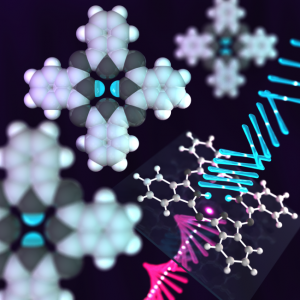Real-time visualization of slow tautomerization in a single organic chromophore Candidate for a 1-nanometer-sized molecular memory

Phthalocyanines (Pc) are 1-nm-sized synthetic organic molecules. Owing to their characteristic light absorption/emission, electronic properties, and planar structures, Pc derivatives often play a key role in various chemical systems such as electronic devices, catalysts, and so on. Recently Pcs have been the focus of research as a potential light source. Especially, tautomerization (the switching in location of an adjacent single and double bond) through transfer of a proton in the central cavity of the molecule is known in the square-shaped free-base phthalocyanine (H2Pc) both theoretically and experimentally. The timescale of the tautomerization of H2Pc in the crystal was experimentally estimated to be fast, that is, over 100,000 times per second at around room temperature. On the other hand, by using theoretical calculations for an isolated H2Pc, much slower tautomerization has been predicted.

© 2014 Tomohiro Ikeda.
Illustration of visualization of tautomerization in a single phthalocyanine molecule using defocused wide-field fluorescence imaging under an optical microscope.
Professor Hiroyuki Noji and Dr. Tomohiro Ikeda at the University of Tokyo Graduate School of Engineering Department of Applied Chemistry and Professor Ryota Iino at the National Institutes of Natural Sciences Okazaki Institute for Integrative Bioscience (formerly Associate Professor at the University of Tokyo Graduate School of Engineering) successfully measured the rate of the tautomerization of an isolated H2Pc molecule at the air/glass interface by using single-molecule optical microscopy. The rate was estimated to be several seconds per transformation, which is consistent with previous theoretical calculations.
This slow event means that the H2Pc molecule meets the requirements to function as a molecular memory: a single molecule that has multiple distinguishable states. Therefore, if it were possible to develop a method to further slow and to control this tautomerization by further chemical modifications and/or external stimuli such as electric fields or light, the H2Pc molecule might function as a molecular memory in the future. By the dense arrangement of H2Pc molecules on a substrate, it should be possible to realize high performance materials capable of storing some 13 terabytes of data per square centimeter.
Paper
Tomohiro Ikeda, Ryota Iino, and Hiroyuki Noji,
“Real-time fluorescence visualization of slow tautomerization of single free-base phthalocyanines under ambient conditions”,
Chemical Communications Online Edition: 2014/5/20, doi: 10.1016/j.stemcr.2014.04.016.
Article link
Links
Graduate School of Engineering
Department of Applied Chemistry, Graduate School of Engineering
Noji laboratory, Department of Applied Chemistry, Graduate School of Engineering (Japanese)







